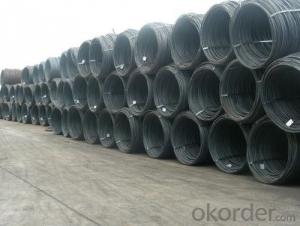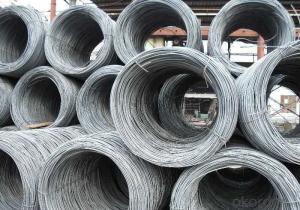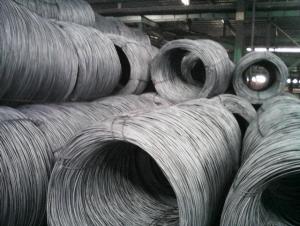Wire rod hot rolled 5.5mm-14mm SAE1006-1018B
- Loading Port:
- Tianjin
- Payment Terms:
- TT OR LC
- Min Order Qty:
- 25 m.t.
- Supply Capability:
- 10000000 m.t./month
OKorder Service Pledge
OKorder Financial Service
You Might Also Like
WIRE ROD Details:
| Minimum Order Quantity: | m.t. | Unit: | m.t. | Loading Port: | |
| Supply Ability: | m.t./month | Payment Terms: | TT OR LC |
Product Description:
Steel Grade: Q195 Standard: ASTM, GB
Diameter: 5.5mm, 6.5mm, 7mm,8mm,9mm,10mm,12mm,14mm
6.5mm can be drawing into 2mm/8.0mm can be drawing into 3mm
Type: Drawn Wire in Coil, each coil weight about 2MT
Brand Name: N-RIVER Place of Origin: Hebei, China
Chemical Composition:
Please kindly find our chemistry of our material based on Q195 as below for your information
Trademark | Rank | Chemical composition (quality score) % | |||||
C | Si | Mn | S | P | |||
| ≤ |
| ≤ | ≤ | |||
Q195 |
| 0.06-0.12 | 0.30 | 0.25 | 0.050 | 0.045 | |
Trademark | Rank | Pulling Test | |||||
Bend PointΔs/Mpa | Tensile Strength | Elongation Ratioδ5% | |||||
Thickness (Diameter) /MM | Thickness (Diameter) /MM | ||||||
≤16 | 16-40 | ≤16 | 16-40 | ||||
≥ | ≥ | ||||||
Q195 |
| 195 | 185 | 315-390 | 33 | 32 | |
Usage and Applications of Wire Rod Q195:
After hot-rolled the products shaped into coil and delivery as finished product, including round, square, rectangular, hexagonal and so on. Since most of the products are round, it is generally called wire rod. Carbon steel wire rod is widely used in construction and manufacturing. Carbon steel wire rod is mainly used for reinforcement of reinforced concrete and welded structure or reprocessed (roberts , nail, etc.) materials, especially used to produce wire drawing, welding electrode, nails, spring, electronic, precise machinery parts and so on
- Q: What are the different types of steel wire rod dimensional inspection methods?
- There are several different types of steel wire rod dimensional inspection methods that are commonly used in the industry. These methods are employed to ensure that the dimensions of the steel wire rods meet the specified requirements and are suitable for their intended applications. Some of the main dimensional inspection methods include: 1. Caliper measurement: This is a basic but effective method that involves using a caliper tool to measure the diameter of the steel wire rod. The caliper provides a quick and easy way to obtain accurate measurements. 2. Micrometer measurement: Micrometers are commonly used for precision measurements in the steel industry. They provide a more accurate measurement than calipers and are typically used to measure the diameter of the wire rod. 3. Optical measurement: Optical measurement methods utilize cameras, lasers, or other optical devices to capture images or collect data about the dimensions of the steel wire rod. These methods can be non-contact and provide high precision measurements. 4. Laser scanning: Laser scanning technology is commonly used to measure the profile or shape of steel wire rods. It involves scanning a laser beam across the surface of the wire rod and capturing the reflected beam to determine the dimensions. 5. Ultrasonic measurement: Ultrasonic measurement methods use sound waves to measure the dimensions of the steel wire rod. Ultrasonic waves are sent through the material, and the time it takes for the waves to bounce back is measured to determine the dimensions. 6. Coordinate measuring machine (CMM): CMMs are advanced measurement systems that use probes and computer software to measure the dimensions of the steel wire rod. They can provide highly accurate and precise measurements. 7. Visual inspection: Visual inspection is a simple method that involves visually examining the steel wire rod for any visual defects or deviations from the specified dimensions. This method is often used as a preliminary inspection before employing more advanced measurement techniques. These are just a few of the various methods used to inspect the dimensions of steel wire rods. Each method has its own advantages and limitations, and the choice of the appropriate method depends on factors such as the required level of accuracy, the complexity of the wire rod's shape, and the available resources and equipment.
- Q: What are the main factors affecting the market promotion of steel wire rod?
- The main factors affecting the market promotion of steel wire rod include the demand and consumption patterns of industries such as construction, automotive, and manufacturing, as they are the primary users of steel wire rod. Additionally, factors such as economic conditions, government policies and regulations, technological advancements, competition from alternative materials, and market trends also play a significant role in influencing the market promotion of steel wire rod.
- Q: What are the standard tensile strength requirements for steel wire rod?
- The standard tensile strength requirements for steel wire rod depend on various factors such as the specific application, industry standards, and regulatory requirements. However, in general, steel wire rod typically has a minimum tensile strength of 500 megapascals (MPa) or 72,500 pounds per square inch (psi). This ensures that the wire rod is strong enough to withstand the expected mechanical stress and loading conditions it will encounter during its intended use. It is important to note that the tensile strength requirements can vary depending on the type of steel, the manufacturing process, and the desired properties of the final product. Therefore, it is crucial to consult the relevant industry standards or specifications to determine the precise tensile strength requirements for a specific application.
- Q: How is the surface roughness of steel wire rod measured?
- The surface roughness of steel wire rod is commonly measured using a device called a profilometer. This instrument scans the surface of the wire rod and provides measurements of the roughness parameters such as Ra (average roughness), Rz (maximum peak-to-valley height), and Rt (total roughness). These measurements help determine the quality and suitability of the wire rod for various applications.
- Q: How are steel wire rods used in the production of piano wire?
- Steel wire rods are used in the production of piano wire by being drawn through a series of dies to gradually reduce their diameter. This process, known as wire drawing, results in a long, thin, and high-tensile strength wire that is then coiled, hardened, and tempered to create the strong and resilient piano wire used in piano strings.
- Q: What are the common applications of high-strength steel wire rod?
- High-strength steel wire rods have a wide range of applications across various industries due to their exceptional strength and durability. Some of the common applications of high-strength steel wire rods include: 1. Automotive industry: High-strength steel wire rods are extensively used in the automotive industry for manufacturing various components such as springs, suspension systems, seat frames, and reinforcement bars. The high tensile strength of these wire rods ensures enhanced safety and stability in vehicles. 2. Construction industry: Steel wire rods find extensive use in the construction industry for reinforcement purposes. They are commonly used to strengthen concrete structures such as bridges, buildings, and highways. The high strength and ductility of these wire rods make them ideal for withstanding heavy loads and seismic forces. 3. Manufacturing industry: High-strength steel wire rods are widely used in the manufacturing industry for producing a variety of products, including cables, wire mesh, nails, screws, and fasteners. The superior strength and durability of these wire rods make them suitable for applications that require resistance to bending, twisting, and tension. 4. Aerospace industry: High-strength steel wire rods find applications in the aerospace industry for manufacturing aircraft components. They are used in the production of cables, control systems, landing gear, and engine components. The high strength-to-weight ratio of these wire rods plays a crucial role in ensuring the safety and reliability of aircraft structures. 5. Energy sector: Steel wire rods are commonly used in the energy sector for various applications. They are utilized in power transmission lines, suspension cables for bridges and power plants, and wire ropes for lifting heavy equipment. The high tensile strength and corrosion resistance of these wire rods make them suitable for withstanding the demanding conditions of the energy sector. 6. Consumer goods: High-strength steel wire rods are also used in the manufacturing of consumer goods such as furniture, appliances, and sporting equipment. They are employed in the production of springs for mattresses and chairs, wire frames for household appliances, and components for fitness equipment. The durability and reliability of these wire rods contribute to the longevity of consumer products. Overall, the common applications of high-strength steel wire rods span across industries, including automotive, construction, manufacturing, aerospace, energy, and consumer goods. Their exceptional strength, durability, and versatility make them a preferred choice for various applications where reliability and performance are crucial factors.
- Q: What are the different welding processes used for steel wire rod?
- There are several different welding processes used for steel wire rod, including MIG welding (Metal Inert Gas), TIG welding (Tungsten Inert Gas), and resistance welding. Each of these processes has its own advantages and is suitable for different applications. MIG welding is commonly used for high-speed production and can handle thicker materials, while TIG welding provides precise and clean welds, making it suitable for delicate and intricate work. Resistance welding, on the other hand, uses electrical resistance to join the wire rod and is often used for spot welding or seam welding applications.
- Q: How is steel wire rod used in the manufacturing of wire rope chains?
- Steel wire rod is the raw material that is used to manufacture wire rope chains. It is first drawn through a series of dies to reduce its diameter and increase its tensile strength. The resulting wire is then twisted and braided together to form the strands of the wire rope chain. This process ensures that the wire rope chain is strong, durable, and able to withstand heavy loads and harsh conditions.
- Q: How is steel wire rod used in the production of tire cords?
- Tire cords rely on steel wire rod, an indispensable element, for their production. These cords are embedded within the rubber of tires to offer strength and support. The steel wire rod undergoes a sequence of steps to achieve the desired form for tire cord manufacturing. To begin with, the steel wire rod undergoes hot rolling, which reduces its diameter and increases its length. This process enhances the wire rod's strength and flexibility, making it suitable for tire cord applications. Following hot rolling, the wire rod is subjected to a heat treatment known as patenting. This treatment improves the wire's mechanical properties, such as tensile strength and elasticity, ensuring it can endure the demanding conditions tires face. Once appropriately processed, the steel wire rod is drawn through a series of dies to attain the desired diameter and surface finish. This drawing process further enhances the wire's strength and surface quality, meeting the strict requirements for tire cord production. Next, the drawn steel wire rod is coated with a layer of brass or zinc to enhance its adhesion to the rubber compound used in tire manufacturing. This coating also provides corrosion resistance, extending the lifespan of the tire cords. Lastly, the coated steel wire rod is twisted into cord structures with multiple strands, forming the tire cord. These cords are then embedded into the rubber during the tire manufacturing process. They play a vital role in reinforcing the tire, enabling it to withstand internal pressure, external forces, and maintain stability during vehicle movement. In conclusion, steel wire rod is an essential material in the production of tire cords. Through a series of processing steps, including hot rolling, heat treatment, drawing, and coating, the wire rod is transformed into durable and high-strength cords. These cords are embedded within the rubber of tires to provide crucial reinforcement and support, ensuring the tires can endure the challenging road conditions they encounter.
- Q: How is steel wire rod used in the manufacturing of coat hangers?
- Steel wire rod is an essential component in the manufacturing of coat hangers due to its strength and flexibility. First, the steel wire rod is typically processed through a series of drawing processes to reduce its diameter and increase its tensile strength. This process results in a long, continuous wire that can be easily manipulated and shaped. To create the frame of the coat hanger, the steel wire rod is then bent and twisted into the desired shape using specialized machinery. The wire can be manipulated to form the main body of the hanger, as well as the hook and any additional features such as trouser clips or notches for straps. The strength of the steel wire rod ensures that the coat hanger can support the weight of heavy garments without bending or breaking. Once the wire frame is formed, it is often coated with a protective layer to enhance its appearance and prevent rusting. This coating can be a layer of paint, plastic, or even a thin layer of chrome. The coating not only provides a decorative finish but also protects the steel wire rod from corrosion, extending the lifespan of the coat hanger. In conclusion, steel wire rod is crucial in the manufacturing of coat hangers as it offers the necessary strength, flexibility, and durability needed to support various types of garments. Its versatility allows for the creation of different hanger designs while ensuring they can withstand the weight and stress of hanging clothes.
Send your message to us
Wire rod hot rolled 5.5mm-14mm SAE1006-1018B
- Loading Port:
- Tianjin
- Payment Terms:
- TT OR LC
- Min Order Qty:
- 25 m.t.
- Supply Capability:
- 10000000 m.t./month
OKorder Service Pledge
OKorder Financial Service
Similar products
Hot products
Hot Searches
Related keywords


























